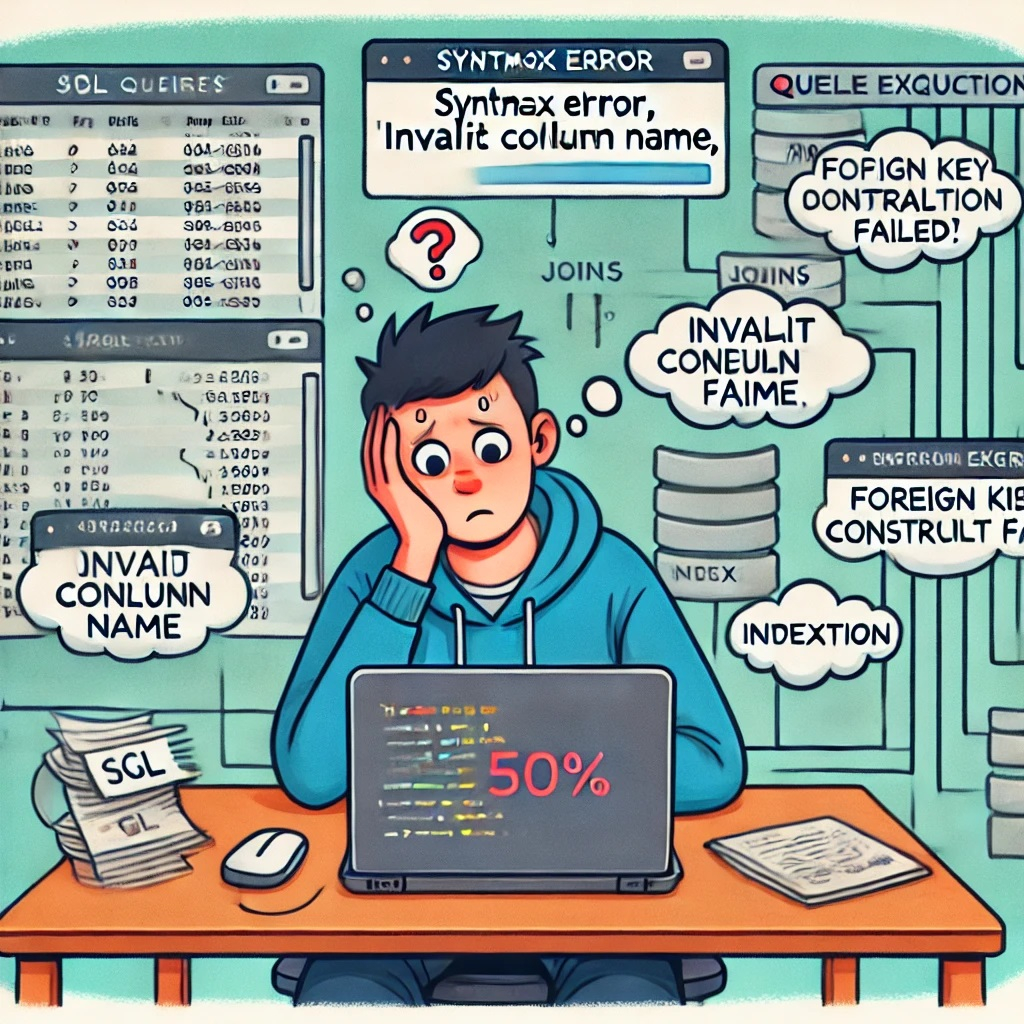Common Challenges Faced by Students in SQL

So, you’re knee-deep in SQL, trying to learn how to organize and manipulate data, and all you’ve gotten so far is a whole lotta confusion and frustration, right? Don’t sweat it. You’re not alone. SQL (Structured Query Language) is like a secret code that helps computers talk to databases, but figuring out how to speak that language can sometimes feel like trying to learn how to juggle flaming swords while riding a unicycle.
If you’re in the middle of learning SQL, chances are you’ve hit a few bumps in the road. Maybe you’ve stared at your screen for an hour, wondering why your query isn’t pulling the right data or why your tables won’t join correctly. It’s OK. SQL’s tough, but with a bit of guidance, you can get the hang of it. Let’s walk through some of the common struggles students face and see how you can power through them.
1. Understanding Joins: A Major Hurdle
Okay, so let’s start with one of the biggest challenges—joins. When you're first getting into SQL, it feels like a whole new world. Tables of data everywhere, and you gotta figure out how to connect them. Sounds simple, right? Nah, not always.
Joins come in different types—INNER JOIN, LEFT JOIN, RIGHT JOIN, and FULL JOIN—each one with a specific purpose. But if you don’t understand the relationship between the tables, things can go south fast. The syntax might look fine, but the results? Not so much. For example, an INNER JOIN can leave out some of your data if it doesn’t match between the two tables. And that can be a huge headache if you’re expecting to see all of it.
A lot of students end up using the wrong type of join and get confused about why they’re not getting the full picture. And then you’re left scrambling through documentation or asking, "Why can’t I just get the data I need?" Sometimes, it takes a little trial and error. But once you’ve used different types of joins a few times, it starts to click. Trust me on that.
2. Syntax and Structure: The Rules Are Tricky
SQL’s syntax rules can trip you up, too. It’s not like writing a regular sentence. You can’t just say whatever’s on your mind; there’s a formula. If you forget a semicolon, or maybe accidentally use the wrong keyword, SQL’s not going to let you get away with it. For example, one tiny slip, like a missing FROM or WHERE, can leave you with a query that doesn’t run, or worse, gives you an incorrect result.
Now, let’s talk about something that makes a lot of students pull their hair out: case sensitivity. Did you know SQL can be case-sensitive in some databases? Yeah, I know, that’s a lot to wrap your head around when you’re just starting. So if you’re getting some odd errors or your query just isn't running the way it should, check your capitalization.
3. Handling NULL Values: The Mystery of Missing Data
Ah, NULL values. The sneaky little devils of SQL. It’s like finding a ghost in your data—something that looks like a value but isn’t quite one. When you’re working with SQL, NULL represents missing or undefined data. Sounds easy, right? But the tricky part is that NULL values behave differently than actual data values.
Let’s say you’re filtering your data with a WHERE clause and you forget that a column has NULL values. You might end up excluding records that don’t meet your conditions, just because they’re missing data. It’s like trying to find your keys in a drawer, but you keep ignoring the drawer because it’s empty. You’ve got to specifically account for NULL when writing your queries. Otherwise, you'll be in the dark, wondering why things don’t add up.
Also, you can’t just use normal comparison operators like = to check for NULL values. No, no. You have to use IS NULL or IS NOT NULL. Get this wrong, and your query will either break or give you inaccurate results.
4. Subqueries: The Nested Chaos
Subqueries—ah, yes. Another fun topic. They’re those queries inside other queries, like the inception of SQL. And while they might seem cool at first, they’re also easy to mess up. A subquery can be used in a SELECT, FROM, or WHERE clause, but the logic can quickly become a confusing mess. The syntax can be a nightmare if you’re not careful. Missing parentheses, misplaced operators, or incorrect placement can all cause issues.
If you’ve been trying to figure out how to use a subquery and feeling like you’re drowning, you’re not alone. The first few times you use them, things might get confusing. But once you understand the purpose of a subquery and how it works, it’s like a lightbulb turning on.
I’d recommend taking it slow with subqueries. Break them down one step at a time. Maybe start with a simple query, then nest another query inside it. Test it out, and as you gain more confidence, you'll start to see the value they bring.
For those of you struggling, you might wanna consider turning to SQL Homework helpers to guide you through the trickier concepts. They can help you understand the logic behind subqueries and give you a fresh perspective on how to structure your queries.
5. Performance Issues: Running Queries That Take Forever
You’ve written your query, and it works fine—well, kinda. But after running it, you notice your database is running slower than a snail on vacation. Oh, and it’s not just this one query. Everything’s sluggish. What gives?
Performance issues can be a huge pain. Some queries run slow because of poor indexing, others because you’re pulling data you don’t even need. If you're not careful, you could accidentally create a query that brings back way too many records or uses inefficient joins. And that? Well, that’s a recipe for disaster in terms of performance.
Sometimes, it’s not obvious what’s causing the slowdown. But if you start paying attention to how you structure your queries and make sure you’re using indexes properly, you’ll get a clearer picture of what’s going wrong. Indexing your tables can speed things up by helping the database find what it’s looking for faster, but if you overdo it, you might just be making things worse.
Another performance issue comes when you’re working with big data sets. When you're pulling thousands or even millions of rows of data, it can take time. One way to make things faster is by using more specific WHERE conditions to narrow down your data or using LIMIT to return only a small subset of results.
6. Data Integrity: Keeping Everything in Check
SQL gives you a lot of power, and with great power comes great responsibility. You’re managing data, and if you’re not careful, you could end up with a mess—duplicate entries, incorrect data, and broken relationships between tables. That’s where data integrity comes into play. Ensuring that your data stays clean, accurate, and consistent is a big part of working with SQL.
This might seem simple on the surface, but as you dive deeper, you’ll see that data integrity involves a lot of checks and balances. For example, when you're inserting or updating records, you need to ensure that the new data doesn’t violate any constraints. This could be anything from foreign key constraints to unique keys or even check constraints. If you try to insert data that violates these rules, SQL will throw an error, and you’ll have to fix it before moving forward.
The hardest part? Getting everything to line up perfectly. Data integrity is often overlooked, but once you start running into issues where the relationships between your tables are messed up, you'll realize how crucial it is to keep everything in check.
7. Working With Complex Data Models
When you’re first starting with SQL, you're probably dealing with simple tables and straightforward queries. But as you progress, you’ll start dealing with more complex data models—ones that involve multiple tables, relationships, and business logic.
This is where things get tricky. You might have to deal with things like normalizing your data (breaking it up into smaller, more manageable tables) or ensuring that your database schema is designed in a way that makes sense for your project. This is when a lot of students get bogged down. The models get more complicated, and figuring out how to organize and query that data in a meaningful way is tough.
But trust me, it’s all worth it once you start seeing how these complex models can work together to produce insightful, actionable data.
Conclusion
SQL may seem overwhelming at first, but the more you practice, the easier it gets. Sure, you’ll run into challenges with syntax, joins, subqueries, and performance, but those hurdles are part of the learning process. SQL’s not something you master overnight, but with patience and persistence, you'll get the hang of it. And hey, even if it feels like you're making no progress at all, you're probably closer to an "aha!" moment than you think. Keep plugging away at it, and pretty soon, those SQL queries won’t seem like such a mystery anymore.
And remember, if things start to feel extra overwhelming, there are always SQL Homework helpers who can lend a hand. Whether you need clarification on a tricky concept or just need someone to point you in the right direction, they can be a valuable resource on your SQL journey.
Read more: Why SPSS Feels Like a Puzzle & How to Crack It?
- Educação
- Course
- Books
- Drawing
- Seção
- Film
- Fitness
- Food
- Jogos
- Gardening
- Health
- Início
- Literature
- Music
- Networking
- Outro
- Programming
- Religion
- Shopping
- Sports
- Curriculm
- Wellness


